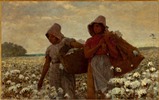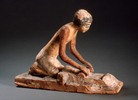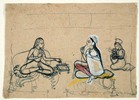









Paintings
Images below are in chronological order and sized approximately to scale relative to each other. *Click images to enlarge*
1. An old woman dozing over a book
Artist: Nicolaes Maes, age 21 (Dutch; born 1634, died 1693)
Medium: Oil on canvas, 32 x 26 inches
Location: Painted in Dordrecht in the province of Holland
Time: Painted in 1655, about seven years after the end of the Eighty Years War and Spanish recognition of the Protestant Dutch Republic's independence from Catholic Spanish rule. Maes had recently married and moved back to his home town of Dordrecht after studying with Rembrandt in Amsterdam.
Woman subject: Maes used this same model for various paintings. Her identity is not known for certain, but it is speculated that she is his mother.
Things to notice: The book the woman is dozing over is the Bible. Her housekeeper's keys are hanging on the wall next to her. Maes' signature is above and to the right of the keys.
2. Young girl reading
Artist: Jean-Honoré Fragonard, age about 38 (French; born 1732, died 1806)
Medium: Oil on canvas, 32 x 26 inches
Location: Painted in Paris
Time: Painted around 1770, about twenty years before the French Revolution. Fragonard had been accepted into the Académie Royale five years previously, but opted to paint for wealthy private clients instead of pursuing a prestigious career as a history painter.
Woman subject: The identity of the model is unknown, but she appears to be of the upper class.
Things to notice: The woman is reading a small portable novel and is sitting in the light of a window. Fragonard uses different kinds of brushstrokes for distinct parts of the painting. The painting is in the Rococo style.
3. The mother and sister of the artist
*Woman artist*
Artist: Berthe Morisot, age 28 (French; born 1841, died 1895)
Medium: Oil on canvas, 40 x 32 inches
Location: Painted in Paris
Time: Begun in 1869 and finished in 1870, the year Napoleon III abdicated the throne and the Third Republic was formed. Morisot's pregnant sister, Edma, had come to stay with her and their mother until the baby was born. Four years later, Morisot and other Parisian artists would put on the first Impressionist Exhibition as an alternative to the prestigious Salon.
Woman subject: Edma is in white; their mother is in black with the book.
Things to notice: Morisot and fellow artist Edouard Manet were friends (she would later marry his brother). The two artists influenced each other. Morisot asked Manet's advice about this painting, and he painted over the mother figure. View the three depictions of women reading, each painted in a different century, side-by-side. What does each portrayal suggest about women in society at the time?
Additional information: The Impressionist artists explored genre scenes as legitimate subjects. As an upper middle class Parisian woman, Morisot couldn't frequent the cafés and dance halls that her male contemporaries painted. She concentrated instead on painting domestic scenes. Still, this thematic trend in art gave women artists more opportunities than they had enjoyed in the past. The preceding European art movements were preoccupied with history painting. These works usually featured nude or semi-nude heroic figures, but women weren't allowed to study anatomy or paint from nude models.
4. Cotton pickers
Artist: Winslow Homer, age 40 (American; born 1836, died 1910)
Medium: Oil on canvas, 24 x 38 inches
Location: Painted in Petersburg, Virginia
Time: Painted in 1876, at the end of the Civil War Reconstruction period, the year that the United States celebrated its centennial. Homer was a correspondent illustrator in the South for Harper's Weekly during the Civil War.
Woman subject: The identities of the subjects are not known.
Things to notice: The perspective on the women is slightly upward, so that they fill the canvas with a strong presence. The woman on the right gazes into the distance as if she is thinking about the future, or her dreams and ambitions. Compare Homer's painting side-by-side with Morisot's painting, done at about the same time. How do you think the gender of the artist impacted these works?
5. Women sewing
Artist: Edouard Vuillard, age about 44 (French; born 1868, died 1940)
Medium: Glue on paper on canvas, 70 x 38 inches
Location: Painted in Paris
Time: Painted around 1912, two years before World War I. Vuillard grew up in a working class family. He was a lifelong bachelor who lived with his mother, a dressmaker, until she died in 1928; his older sister was also a dressmaker.
Woman subject: The identities of the subjects are unknown; perhaps they are Vuillard's sister and mother.
Things to notice: This painting is nearly six feet tall. Vuillard used the medium of peinture à la colle. Vuillard's style and technique evolved over time, but throughout his career he was known for his genre depictions of interior spaces.
Other works (prints, sculpture, drawing)
Images below are in chronological order and sized approximately to scale relative to each other (three times the scale of the painting images above). *Click images to enlarge*
6. Model of a woman grinding grain
*Gender of artist is unknown*
Artist: Artist unknown (Egyptian)
Medium: Wood sculpture, gessoed and painted, 7.2 inches tall
Location: Made in Egypt
Time: Made around 2134 B.C. to 1991 B.C., in the First Intermediate Period to early Middle Kingdom
Woman subject: The identity of the subject is not known, but she is probably a servant. Statues of servants doing chores were included in tombs so that the deceased would continue to benefit from their service in the afterlife.
Things to notice: During the Old Kingdom, artists were concentrated in Thebes and used mathematical ratios to proportion the bodies of their figurative sculptures accurately. But between the Old Kingdom and the Middle Kingdom, artists were decentralized due to political upheaval and conventions of proportionality were lost. For instance, the arms and torso of the woman in this sculpture are disproportionately long compared to her legs.
7. Woman spinning and visitor
Artist: Israhel van Meckenem the Younger, age about 50-60 (German; born around 1440/1445, died 1503)
Medium: Engraving, 6.5 x 4.4 inches
Location: Made in Bocholt, Germany
Time: Printed around 1495-1503, when Germany fragmented into 300 states. Meckenem did this engraving sometime in the last eight years of his life. Meckenem dominated engraving in northwest Germany in the 1400s. Many of his works were copied from various masters, including Albrecht Dürer. This engraving, however, is one of twelve in a series of original art called "Scenes of Daily Life."
Woman subject: The identities of the subjects are not known.
Things to notice: Meckenem's genre scenes document the clothing and interior fashions of his time. Notice the rather odd-looking cat on the floor and the artist's initials at the bottom.
8. Women playing a game of chess
*Gender of artist is unknown*
Artist: Artist unknown (Indian)
Medium: Drawing, ink and opaque watercolor on paper, 5.6 x 8.0 inches
Location: Made in Bundi in the state of Rajasthan
Time: Made around 1700, during Muslim rule of Hindu Rajasthan. Chess was always popular in India.
Woman subject: The identities of the subjects are not known.
Things to notice: The woman in watercolor, waiting her turn to move, is smoking tobacco in a huqqa. This scene may depict the zenana, women's private quarters in a royal household. The women are not wearing veils: elite women wore veils in public during this period. Notice the somewhat large, oval faces in profile and straight noses, characteristics of the Bundi style beginning in the late 17th century.
9. Young women in a theater balcony
Artist: Utagawa Kunisada (Toyokuni III), age about 34-44 (Japanese; born 1786, died 1865)
Medium: Color woodcut print, 14.6 x 9.6 inches
Location: Made in Edo (i.e. Tokyo)
Time: Printed in the 1820s during the shogunate established by Tokugawa Ieyasu in 1600. Japan was isolated from the West: Westerners and Christianity were banned. Toyokuni I died and Kunisada took over the Utagawa studio around the time he made this print. This is also when he made a name for himself with his bijinga series ("pictures of beautiful women").
Woman subject: The identities of the subjects are not known.
Things to notice: This is one sheet of a triptych. Ukiyoe prints were made for common use and cost about the same as a bowl of noodles. Kunisada himself designed about 50,000 prints. Notice the elongated faces and elaborate costumes; later Kunisada would adopt a more naturalistic style.
10. The fitting
*Woman artist*
Artist: Mary Cassatt, age 46 (American; born 1844, died 1926)
Medium: Drypoint and aquatint print on laid paper, 18.8 x 12.1 inches
Location: Made in Paris
Time: Printed in 1890-1891, during the French Third Republic established in 1870 that continued until World War II. Cassatt was an American expatriate who had been living in France for sixteen years when she made this print. Cassatt had her first individual exhibition at this time, and she produced a group of eighteen color prints during the 1890s.
Woman subject: The identities of the subjects are not known.
Things to notice: Mirrors in art are often associated with feminine vanity, but in this work the subject is looking away from the mirror, which extends the compressed space. Like many of her fellow Impressionists, Cassatt was influenced by Japanese prints. This print synthesizes a bold, abstract, Japanese-inspired composition with Western themes. Compare this print side-by-side with the Kunisada print. Do you see any evidence of the influence of Japanese prints on Cassatt's work?
Additional information: Cassatt was part of the Impressionism movement that legitimized genre subjects in art. The Impressionists admired Japanese ukiyoe prints in part because they depicted everyday life. Women Impressionists often concentrated on indoor scenes because they didn't have the same freedom as men to move about outside on the boulevards. Their depictions of domestic life reflected a perspective unavailable to men.
Image sources:
1. Maes, Nicolaes. An old woman dozing over a book. Painting. National Gallery of Art. Washington. 9 Dec. 2013. https://images.nga.gov/
2. Fragonard, Jean-Honoré. Young girl reading. Painting. National Gallery of Art. Washington. 11 Dec. 2013. https://images.nga.gov/
3. Morisot, Berthe. The mother and sister of the artist. Painting. National Gallery of Art. Washington. 11 Dec. 2013. https://images.nga.gov/
4. Homer, Winslow. Cotton pickers. Painting. Los Angeles County Museum of Art (LACMA). Los Angeles. 11 Dec. 2013. http://www.lacma.org/
5. Vuillard, Edouard. Women sewing. Painting. National Gallery of Art. Washington. 12 Dec. 2013. https://images.nga.gov/
6. Model of a woman grinding grain. Sculpture. Los Angeles County Museum of Art (LACMA). Los Angeles. 9 Dec. 2013. http://www.lacma.org/
7. Meckenem the Younger, Israhel van. Woman spinning and visitor. Print. Los Angeles County Museum of Art (LACMA). Los Angeles. 9 Dec. 2013. http://www.lacma.org/
8. Women playing a game of chess. Drawing. Los Angeles County Museum of Art (LACMA). Los Angeles. 11 Dec. 2013. http://www.lacma.org/
9. Kunisada (Toyokuni III), Utagawa. Young women in a theater balcony. Print. Los Angeles County Museum of Art (LACMA). Los Angeles. 11 Dec. 2013. http://www.lacma.org/
10. Cassatt, Mary. The fitting. Print. National Gallery of Art. Washington. 12 Dec. 2013. https://images.nga.gov/